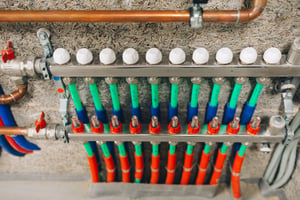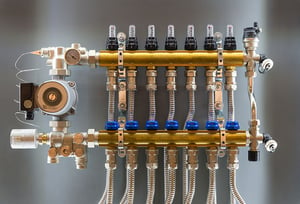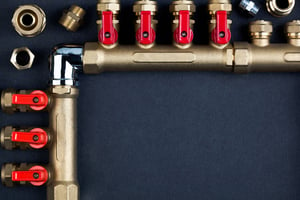In the industrial industry there are many instances where two or more requirements must be fulfilled at the same time. Combining gases or fluids, controlling multiple valves, operating pneumatic and hydraulic systems can all demand that multiple functions be performed simultaneously. Incorporating a manifold into a fluid power application in hydraulics or pneumatics can provide an easier and more efficient performance.
 A manifold is a fluid or gas distribution system or device that serves to bring many valves into one place or a single channel into an area where many points meet. Manifold systems can range from simple supply chambers with several outlets, to multi-chambered flow control units. They are typically used to divide one supply input to multiple outputs. More complex systems can incorporate integral valves or an electronic network interface.
A manifold is a fluid or gas distribution system or device that serves to bring many valves into one place or a single channel into an area where many points meet. Manifold systems can range from simple supply chambers with several outlets, to multi-chambered flow control units. They are typically used to divide one supply input to multiple outputs. More complex systems can incorporate integral valves or an electronic network interface.
Manifolds are made up of several key components. A hollow container in the form of a pipe or tube is used to move fluid. Tees, elbows, crosses, plugs, and other parts are used to fit the pipe and tube to the manifold. The flow of the fluids through the ports of the manifold is controlled by having one or more valves attached. Measurement is tracked by pressure gauges, switches, and other devices attached to the manifold.
Along with their make up of many components, manifolds can be made out of a variety of materials. Depending upon the type of material that makes up a manifold, fluid compatibility and performance will be affected. The most common types of materials that make up a manifold are aluminum, ductile iron, plastic, steel, and stainless steel. A common feature throughout all these materials is they must be able to provide corrosion and wear resistance. Although each provide corrosion and wear resistance to some extent, their corrosion and wear resistant ability will perform differently depending upon the chemical or fluid flowing throughout the system. For example, a manifold made from aluminum might have a stronger resistance to a specific oil, then say a manifold made from plastic. The selection of what type of material a manifold should be made of will come down to the type of chemical or fluid flowing throughout the system it will be used in.
 The two most common types of manifolds that will be used in industrial automation are hydraulic and pneumatic manifolds. Both provide a distribution point for compressed air, gases, and fluids to redirect pneumatic or hydraulic power to equipment throughout a facility. Both a hydraulic and pneumatic manifold can be constructed as two forms of manifolds. First is a single-piece design. In a single-piece design all necessary valving and passages for the entire system are supported on that one device. The other, a modular block design, is a construction of multiple blocks designed to be used as an individual unit or assembled into a modular combination to make up a complete system.
The two most common types of manifolds that will be used in industrial automation are hydraulic and pneumatic manifolds. Both provide a distribution point for compressed air, gases, and fluids to redirect pneumatic or hydraulic power to equipment throughout a facility. Both a hydraulic and pneumatic manifold can be constructed as two forms of manifolds. First is a single-piece design. In a single-piece design all necessary valving and passages for the entire system are supported on that one device. The other, a modular block design, is a construction of multiple blocks designed to be used as an individual unit or assembled into a modular combination to make up a complete system.
No matter the type or construction style of the manifold they all work in the same way. If a comparison of how it works were to be made it would be to that of a switchboard in an electrical circuit. An electrical circuit works by the operator having complete control of redirecting the signal into the output of their choosing. This ability to redirect electricity is available due to the switchboard providing switches. Similarly, an operator working with a manifold can redirect fluid flow into the output of their choosing, thanks to the integrated valves or electronic network interface attached to the manifold. With the valve or interface, the operator can pick and choose the exact line the fluid must travel through to power the machinery it is operating.
 Manifolds can be found in a variety of equipment and applications throughout multiple industries. In the food and beverage industry they can be used to control the regulation of fluid flow in filling bottles. The medical industry uses them in blood analyzers, clinical diagnostics, laboratory equipment, and dialysis equipment. The agriculture industry uses them on planters, tractors, sprayers, and harvesters. Industrial industries use manifolds on forklifts and manufacturing equipment. Oil and gas use them with oil exploration, hydraulic fracturing, and extraction systems. Their ability to regulate fluid flow or power heavy machinery finds their use endless.
Manifolds can be found in a variety of equipment and applications throughout multiple industries. In the food and beverage industry they can be used to control the regulation of fluid flow in filling bottles. The medical industry uses them in blood analyzers, clinical diagnostics, laboratory equipment, and dialysis equipment. The agriculture industry uses them on planters, tractors, sprayers, and harvesters. Industrial industries use manifolds on forklifts and manufacturing equipment. Oil and gas use them with oil exploration, hydraulic fracturing, and extraction systems. Their ability to regulate fluid flow or power heavy machinery finds their use endless.
There are multiple advantages when it comes to manifolds. The overall layout of the machine it will be a part of will be improved. It will allow for more space and a cleaner appearance, due to less cumbersome hoses and fluid connections. It will also increase energy efficiency due to shorter flow paths that minimize pressure drop and heat fluctuations. Manifolds reduce installation costs and fluid connections due to simpler compact design. They also lower the chance of oil leaks because of they reduce fatigue, and wear on joints.
Manifolds provide a convenient solution for multiple output lines. They can be used as a conjunction of multiple lines, a supply chamber, or source of power for heavy machinery. They are an asset that can provide more advantages then disadvantages.
Learn more about how Radwell can assist you with your manifold purchases and repair needs

